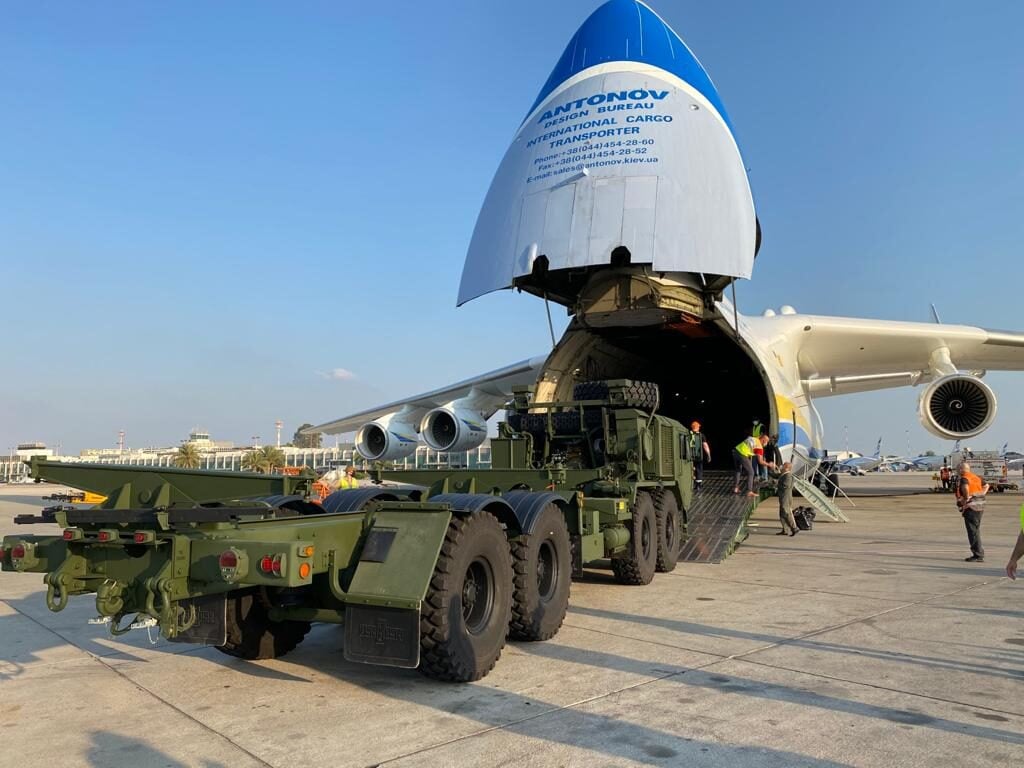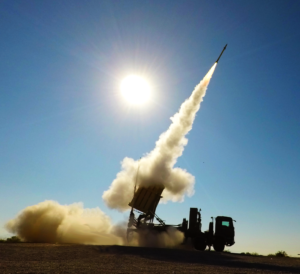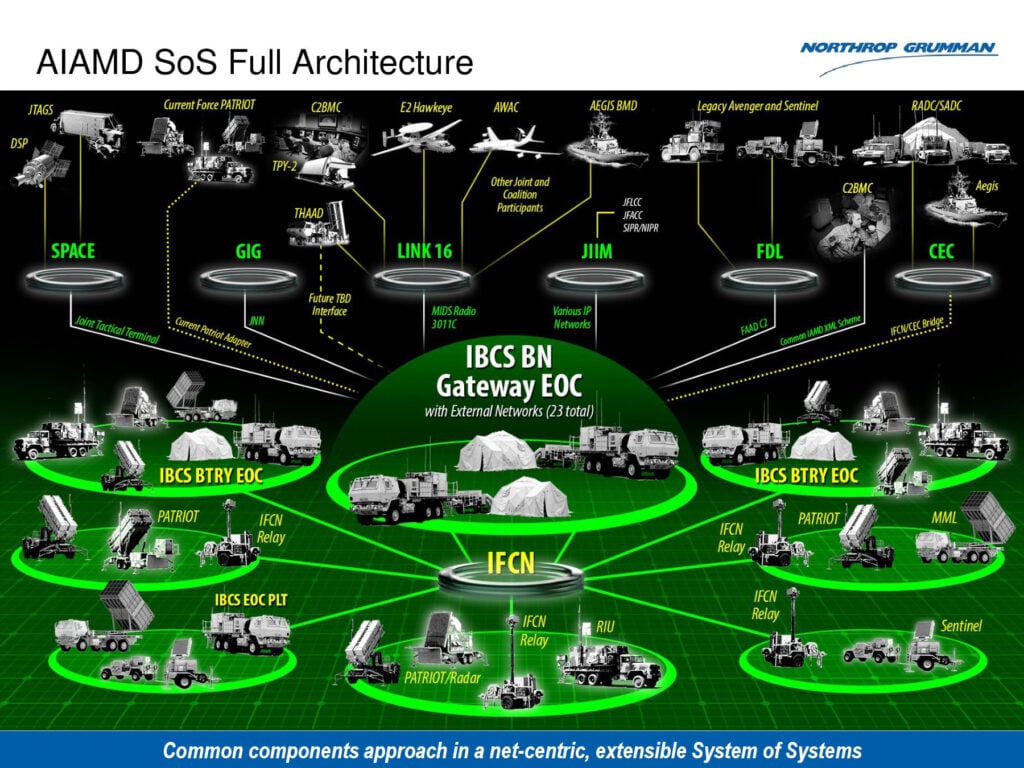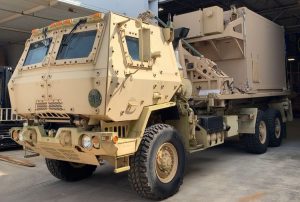
An An-225 jet transport offloads an Oshkosh military truck at Ben Gurion Airport (Credit: Israel Airports Authority)
TEL AVIV: Earlier today, a giant Antonov 225 jet transport landed at Ben Gurion Airport, carrying US-made Oshkosh military trucks. Israeli armsmaker Rafael will mate those heavy-duty vehicles with its Iron Dome missile defense system before shipping the first battery of the weapon to America this fall.
Rafael and its US partner, Raytheon, are so confident in the future of the program that, this morning, they announced a joint venture to manufacture Iron Dome at a location to be determined in the US. (New financial incentives to spend US aid in the US also play a role). But the two batteries the Army has so far committed to purchase will be built in Israel. The really hard part is yet to come: figuring out the knotty technical details of how to connect the Israeli system to the American networks that command, control, and coordinate US forces.

A Tamir interceptor launches from truck-mounted Iron Dome launcher.
“Right now … the first battery should arrive in the United States no later than the end of December,” Brig. Gen. Brian Gibson, the Army’s modernization director for air & missile defense, said in an interview last week with Breaking Defense ahead of Tuesday’s SMD conference. (Click here for the first half of that interview). After integration, testing, and training, the unit should be ready for real-world operations by September 2021. A second battery arrives in the US in February next year and will be combat-ready by the end of 2021.
That’s all the Army plans to buy, for now, to serve as an “interim Indirect Fire Protection Capability” against artillery rockets and cruise missiles. The “enduring” IFPC will likely be a completely different system, although it may include components of Iron Dome. The US plans to hold a “shoot-off” of potential missiles for IFPC at White Sands Missile Range next year, between April and June, and to select a single vendor by the fall. The Army’s urged Rafael and Raytheon to enter Iron Dome’s Tamir missile in the competition, but all entrants must show that they’re compatible with the service’s new IBCS network.
While Gibson tactfully declined to say so, US Army leaders were reluctant to buy the Iron Dome – it was forced on them by Congress as a stopgap after IFPC encountered problems and delays – and they’ve repeatedly, publicly questioned how well the Israeli system will exchange data with American equipment. Iron Dome’s advocates counter that the Marine Corps managed a successful demonstration last year with the system linked to their G/ATOR radar, so why couldn’t the Army make it work just as well?

A simplified (yes, really) overview of the Army’s IBCS command-and-control network for air and missile defense.
The US soldiers operating Iron Dome batteries will have their usual secure radios and other means to talk with other units. But voice communications are far too slow and imprecise to pass detailed tracking data on incoming threats, let alone targeting data, which requires split-second precision to shoot down an enemy missile or rocket in flight – without shooting down a friendly aircraft by mistake. That’s the kind of information that must be shared machine-to-machine. Getting US Army computers to talk to foreign ones can be a true technical challenge.
“The voice side of communications I’m not concerned about,” Gibson told Breaking Defense. In the two “Interim IFPC” batteries using Iron Dome, he said, “we’ll be able to have access to our voice communications nets, both secure and unsecure, just like any other US unit.”
“The data side, we still don’t know we can integrate it,” he said. “That’s part of the effort that’s in front of us.”
Gibson is looking at three different levels of integration. In layman’s terms:
- Side-by-side screens: At the minimum, the Army will put a new tactical display inside the Iron Dome command posts, a terminal plugged into the Army’s real-time “combined air picture” showing the locations of friendly, neutral, and hostile objects, from planes to missiles. But the Army terminal showing the “air picture” would be separate from Iron Dome’s built-in displays showing the view from Iron Dome’s own radars. To get the complete picture, the human operators will have to look from one screen to the other and back again, which raises the risk of a lethal mistake.
- Machine-to-machine interoperability: What the Army, Rafael and Raytheon really want is to connect Iron Dome directly to other Army systems, so they can exchange at least some data automatically machine-to-machine, without human intervention. The more tracking and targeting data that can go directly to Iron Dome, the more complete the picture that the operators get at a glance. The Marine Corps reportedly managed to connect Iron Dome with their G/ATOR radar in this way.
- IBCS integration: Ideally, the Army wants to fully integrate Iron Dome with its future Integrated Air & Missile Defense Battle Command System, known as IBCS. This network pulls in data from a wide range of different Army radars that don’t currently connect – and potentially from non-Army ones like the Air Force F-35 as well – and compile it into highly accurate targeting data that can be used by any Army anti-aircraft or missile defense system.
IBCS is now in testing in at White Sands Missile Range, where it will fire Patriot missiles at live targets this month. New Army systems like the LTAMDS radar will be IBCS-compliant from the start, but it will take years of effort and millions of dollars to backfit existing US systems, let alone foreign ones.

The mobile command post for the Army’s new IBCS air and missile defense network.
“We’re, as a bridging solution, going to install a suite of data communications capabilities,” Gibson said, “[but] we intend, though, to not stop there and see if we can in fact integrate it with IBCS.”
How integrated can Iron Dome get? “We don’t know yet,” the head of Army Futures Command, Gen. Mark Murray, told Breaking Defense in March. “My assessment right now is, it would be — and I hate to ever use the word ‘impossible’ — but exceptionally difficult to integrate Iron Dome into our layered air defense architecture [and] to get Iron Dome talk to other systems, other radars, specifically the Sentinel radar.”
Iron Dome’s defenders would argue that the US Army has so far only looked at technical data and has not gotten their hands on a working Iron Dome system and learned what does and doesn’t work. That opportunity will come once the first battery is delivered this fall.
Iron Dome is highly regarded for its success shooting down unguided artillery rockets launched by Hezbollah and Hamas. But the US also wants to test its capability to intercept cruise missiles, a much harder target.
In a ‘world first,’ DARPA project demonstrates AI dogfighting in real jet
“The potential for machine learning in aviation, whether military or civil, is enormous,” said Air Force Col. James Valpiani. “And these fundamental questions of how do we do it, how do we do it safely, how do we train them, are the questions that we are trying to get after.”


























